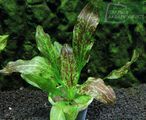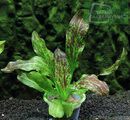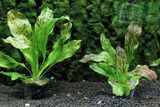Echinodorus Green Flame

Origin / Breeder : Hans Barth, Dessau [1]
Plant type: rosette with oval leaves Plant color: dark green pigment spots on young leaves, pigmentation of part of the leaf plate Additionally: suitable for beginners, suitable for aquariums from 50 cm Additional application recommended fertilization, medium lighting, strong lighting Description: Echinodorus Green Flame - is a selection form of Echinodorus Ozelot, belongs to quite large representatives with a large number of leaves and looks very impressive in the aquarium. The photo shows Echinodorus Green Flame and Echinodorus Ozelot green for comparison. This is the only way to understand that they are two different species.
Height: 10 - 30 cm Width: 10 - 20 cm Keeping conditions: Acidity: 5 - 8 pH. Hardness: 1 - 30 dH. Temperature: t 20 - 30 ° C. Lighting: Medium. Growth rate: Average. Keeping conditions: Easy.
Echinodorus Green Flame is a selective form of Echinodorus Ozelot. In contrast to Echinodorus Red Flame, it has a red spot on a green background and an olive-colored spot in the second. This Echinodorus is a large representative with a large number of leaves and looks particularly impressive in large aquaria. Used as a solitary plant in the center plan of the aquarium. Easily transfers the transplant, quickly recovers, gains strength, begins to form new leaves. In good conditions, the mother bush can reach a height of 30 - 40 cm with almost the same rosette diameter. Prefers nutritious, humus-rich soil and bright light. It is undemanding to the chemical parameters of water, it feels good in both soft and hard water at a pH of 6 - 8. The optimum temperature of the content is 20 - 28 ° C. Root treatment and additional supply of carbon dioxide improve the appearance of the plant and accelerate its growth rate. Propagated by flowering shoots, in the nodes of which young are formed, intensively overgrown with roots and leaves. Once the root system has developed sufficiently, the daughter process can be cut off and planted. Due to its unpretentiousness, it is also recommended for beginners.[2]
-
Echinodorus Green Flame[3]
-
Echinodorus Green Flame[3]
-
Echinodorus Green Flame[3]
-
Echinodorus Green Flame[3]
- ↑ Christel Kasselmann, Taschenatlas Aquarienpflanzen ISBN:9783800159093 https://www.christel-kasselmann.de/
- ↑ Kostiantyn Loboda, Black Water http://echinodorus.com.ua/
- ↑ 3.0 3.1 3.2 3.3 Roman Trifonov, Moskau Aquarium Pflanzen http://www.staraqua.ru/




